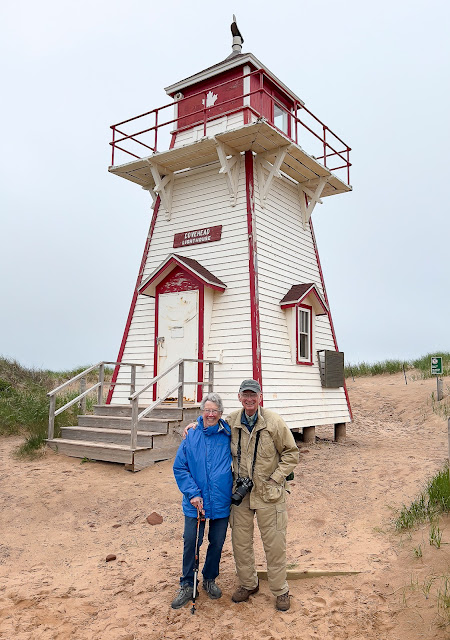The eight mile long Confederation Bridge was opened in 1997. The idea of a bridge was heatedly debated before a referendum passed by 59.4%. It transformed life on the island and eventually gained widespread approval. We arrived at the bridge on a windy, rainy morning. New visitors frequently stop at the viewpoint on Cape Jourimain as these young people did. The ride across the bridge is smooth, but we'd have liked to have had a clearer view.
Once on the island, one soon sees hallmarks of this small province with only about 150,000 residents. The sea is always nearby, so a great variety of lighthouses are seen. This is Cape Bear Lighthouse where the first radio message was received from the stricken Titanic.
Largely, the lighthouses are wooden. The island lacks hard stone that is so often used elsewhere.Two more constants are flowering lupines and small fishing harbors. The lupines are widespread.
There is abundant seafood to feast upon. This lunch featured a fresh haddock sandwich and bay scallop tacos, both with PEI potato salad and cabbage slaw. You can't drive more than 5 kilometers without passing a field of potatoes.
Another certainty is friendly people. Pam and I agree that the residents are another hallmark.Our first three days were marked by cloudy and breezy days - not ideal for photography but fine to explore. On several occasions, we visited locations marked by seaside tragedies. This is Covehead Lighthouse.
Bruce is building a home on Yankee Hill with a ocean view that includes a view of this lighthouse on London Bay.
It may seem unusual to include cemeteries in an itinerary, but in Atlantic Canada, they are a continuing link to people's pasts. We stopped at the Brackley Beach Cemetery on the north shore where two ladies were unloading trays of flowers for placing on markers of family members. In Cavendish Cemetery, this marker honoring mariners lost in earlier mentioned Yankee Gail of 1851. At a cemetery in Georgetown, this marker remembers a boy lost at age four. Note the childhood ornaments for those who died young. I've seen this elsewhere.At our last hotel in Montague, I woke for the very early sunrise. The highway bridge was lined with planters full of petunias.
The sunrise was framed with three large cast sculptures of cormorants.
It was now time to head home. Again, we stopped at the Confederation Bridge for one last look.
We paid our $50.25 toll and returned home..
One last comment is for golfers. The island has many lush courses that could be imagined to be in Scotland- rolling hills, sandy bunkers and picture perfect greens. We met several people touring across the island for a new course each day. Sadly, I was terrible at golf.
Paul Schmitt



.jpg)



















